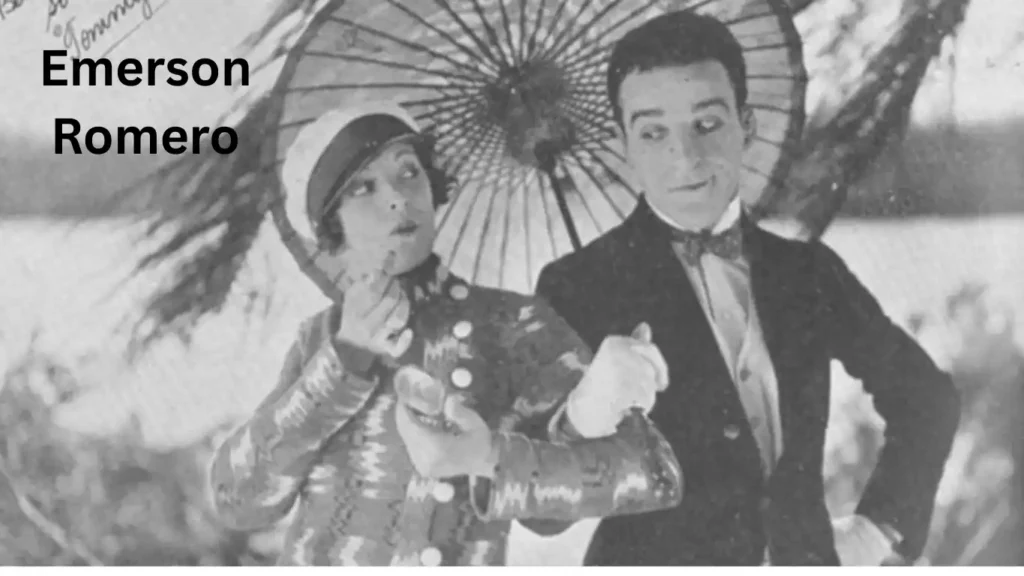Who Was Emerson Romero?
Emerson Romero was one such silent film pioneer.
Born in 1900, he emerged as one of the first deaf actors in Hollywood.
You may not be hearing his name as frequently as Charlie Chaplin or Buster Keaton, but the contribution made by him was quite extraordinary.
Romero was more than an actor — he was also a director and an entrepreneur.
His career as a film maker is a tale of bravery, imagination, and overcoming obstacles.
During a time when silent films were on the screen, Romero’s innate acting ability flourished without the use of spoken words.
Despite difficulties in his career, he created a legacy that influenced accessibility in film.
Early Life and Background
Emerson Romero was born in Havana, Cuba, in 1900.
He lost his hearing at an early age, but that did not discourage him from pursuing acting.
During those times, the world was not as receptive to deaf actors as it is now.
Chances were few and far between, but Romero possessed a certain charm that worked well for him.
He emigrated to the United States, where he found his niche in the entertainment industry.
During those early years, Hollywood was alive with energy, creativity, and competition.
Romero’s persistence made him stand out in a field of many.
His Cuban background and his talent for portraying emotion made him unforgettable on screen.
Career as an Actor in Silent Films
Silent films were ideal for Emerson Romero.
Since there was no dialogue, actors must use facial expressions and gestures.
Romero was good at this.
He had a talent for reaching audiences that seemed natural and effortless.
Most silent film stars made dramatic use of movement to convey a story.
Romero introduced a natural, accessible approach to acting.
That approach won him favor with directors and actors.
Some perceived his deafness as a weakness, but Romero used it as a strength.
Transition from Acting to Film Editing
When “talkies” — sound films — came along, everything changed overnight.
For deaf actors like Emerson Romero, it meant fewer roles.
But for Romero, that didn’t end his acting career.
He transitioned instead into film editing, where his close attention to detail really paid off.
Editing back then was nothing like it is now.
It involved cutting and splicing together physical strips of film.
Romero set about it with care, ensuring that each frame was perfect in telling the story.
His life behind the camera was as valuable as it was in front of it.
Pioneering for the Deaf
Emerson Romero’s most significant contribution was that he paved the way for making movies accessible to the deaf.
There were no captions on movies when cinema was in its early days.
Romero developed a technique to lay text directly onto the film frames.
This enabled deaf audiences to keep up with dialogue and narrative.
His concept was groundbreaking for its day.
Though the industry didn’t embrace his technique immediately, it led the way to closed captions today.
Millions of individuals are now helped by accessibility in media — and Romero’s pioneering work should be acknowledged.
It’s another instance of how he considered beyond his career to assist others.
Challenges Faced
Being a deaf actor during the early 20th century was not easy.
Hollywood was full of discrimination and ignorance.
Romero tended to work harder than others to establish himself.
Nevertheless, he did not give up, being resilient and creative at each step.
The advent of sound films was one of the greatest challenges.
Most silent movie stars were out of work when talkies gained popularity.
In Romero’s case, it meant discovering new paths to remain involved in the profession he cherished.
His transition into editing and innovation demonstrated his resilience and adjustability.
Life Outside of Movies
Emerson Romero was not just about films.
He was also deeply rooted in the deaf world, both within the U.S. and abroad.
He felt passionately about providing opportunities for deaf individuals across professions.
With his contribution and impact, he motivated a lot of people to pursue their interests regardless of obstacles.
His friendly, accessible nature made him extremely popular among friends and peers.
Communication, whether in the form of sign language, gesture, or written texts, was important to Romero.
Life depicted that the essence of expression is beyond voice.
Legacy and Lasting Impact
Although Emerson Romero is not a well-known individual today, his legacy persists.
His accessibility work revolutionized the way individuals with hearing loss consume entertainment.
By advocating for captions and making movies more accessible, he paved the way for generations to come.
In deaf cinema history, Romero is an icon.
He proved talent has no boundaries — hear or not.
His legacy continues to motivate actors, directors, and accessibility advocates across the globe.
Why We Should Remember Emerson Romero
It is easy to overlook pioneers as time goes by and new stars appear.
But honoring individuals like Emerson Romero is important.
He showed that one can evolve, innovate, and still shine despite the changing world.
His life reminds us that with creativity and determination, one can break barriers.
In a sense, his professional life mirrors the story of silent cinema itself — evocative, emotive, and enduring.
Romero’s work transcends entertainment; they’re part of social advancement.
Fun Emerson Romero Facts
He was connected to the popular actor Cesar Romero, who played the Joker on the 1960s Batman show.
Romero’s captioning process entailed physically cutting into and inserting text onto film frames.
He appeared both in front of and behind the camera — an unusual occurrence at the time.
His accessibility concepts were well ahead of mainstream implementation.
Final Thoughts
Emerson Romero’s life is one of determination, dedication, and creativity.
From his days as a silent film star to his pioneering efforts with deaf audiences, he left an indelible mark.
He was not necessarily the loudest voice in Hollywood, but his presence was loud enough to be heard throughout the ages.
Romero is a reminder that sometimes art doesn’t require sound.
Sometimes the softest contributions are the ones that make the greatest noise.



